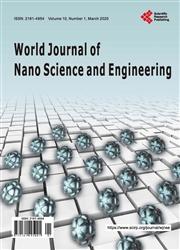Measurements of Pulsed 532 nm Laser Breakdown Spectroscopy of Synthesized Magnetite Nanoferrofluid
引用次数: 1
Abstract
We describe the results of 532 nm pulse laser-induced breakdown spectroscopy (LIBS) of two samples of magnetite nanoparticles (SPIONs) nanoferrofluid synthesized at room (S1) and elevated temperatures (S2) and at three different laser energy levels and pulse frequency. The size of magnetite nanoparticles, size distribution, magnetic crystalline phase and magnetization were analyzed and measured using transmission electron microscopy (TEM), X-ray diffraction spectroscopy (XRD) and vibrating sample magnetometry (VSM). The SPIONs showed a distribution between 4 - 22 nm with a peak about 12 nm and saturation magnetization of about 65 emu/g. The Saha-Boltzmann analysis of spectra for medium energy level (1050 mJ) yields plasma temperatures of (3881 ± 200) K and (26,047 ± 200) K for Fe I and OV as the lowest and highest temperatures respectively. A range of corresponding electron density (Ne-) of (0.47 - 6.80) × 1020, (0.58 - 8.30) × 1020 and (0.69 - 9.96) × 1020 cm-3 were determined at 860, 1050 and 1260 mJ respectively using the estimated CCD pictures. The results confirmed a higher elements ratio for S1 than S2 and the signal intensity indicated a non-linear behaviour as a function of pulse frequency with the maximum ratio value at 3 Hz. At higher frequency of 6 Hz no such turning point was observed. The highest and lowest temperatures corresponded to Fe I and OV respectively. The LIBS technique can be utilized to study, characterize and determine the elements ratio required in most applications involving the synthesizing process.合成磁铁矿纳米流体的脉冲532 nm激光击穿光谱测量
我们描述了在室温(S1)和高温(S2)下以及在三种不同的激光能级和脉冲频率下合成的两种磁铁矿纳米颗粒(SPIONs)纳米铁磁流体样品的532nm脉冲激光诱导击穿光谱(LIBS)的结果。利用透射电子显微镜(TEM)、X射线衍射光谱(XRD)和振动样品磁强计(VSM)对磁铁矿纳米颗粒的尺寸、尺寸分布、磁性结晶相和磁化强度进行了分析和测量。SPION的分布在4-22nm之间,峰值约为12nm,饱和磁化强度约为65emu/g。中等能级(1050 mJ)的Saha Boltzmann光谱分析得出,Fe I和OV的等离子体温度分别为(3881±200)K和(26047±200)K。在860、1050和1260 mJ处分别测定了相应的电子密度(Ne-)范围为(0.47-6.80)×1020、(0.58-8.30)×1020和(0.69-9.96)×1020cm-3。结果证实S1的元素比高于S2,并且信号强度指示作为脉冲频率的函数的非线性行为,最大比值为3Hz。在6Hz的较高频率下,没有观察到这样的转折点。最高和最低温度分别对应于Fe I和OV。LIBS技术可用于研究、表征和确定涉及合成过程的大多数应用中所需的元素比例。
本文章由计算机程序翻译,如有差异,请以英文原文为准。
求助全文
约1分钟内获得全文
求助全文

 求助内容:
求助内容: 应助结果提醒方式:
应助结果提醒方式:


